Reserve Bank of Australia Annual Report – 1994 Financial Markets
Recent Developments
Financial markets took a major turn in direction during the 1993/94, driven largely by changing assessments about the economic outlook in Australia and abroad. What were relatively pessimistic views early in the year were steadily replaced by greater optimism as the year progressed. In Australia, this was reflected most clearly in the turnarounds in the exchange rate and the bond market. It was evident to a lesser extent in short-term security yields, which were relatively flat until mid 1994, when they kicked up on the back of expectations of a tightening of monetary policy.
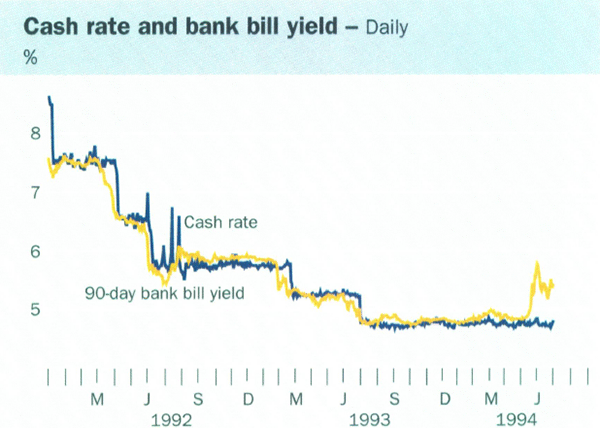
The Australian dollar, which had been on a downward trend since late 1991, continued that trend in the opening months of 1993/94. Pressured by doubts about whether the August Budget would be passed, the trade-weighted index of the Australian dollar reached a new low of 47.1 in September 1993, more than 20 per cent below its level in September 1991. That proved to be an over-reaction by the market and, aided by some substantial Reserve Bank intervention and an improving economic outlook, the exchange rate started to recover strongly in October 1993 and continued to do so through to January. Since then it has been mainly within a TWI band of 53 to 54.
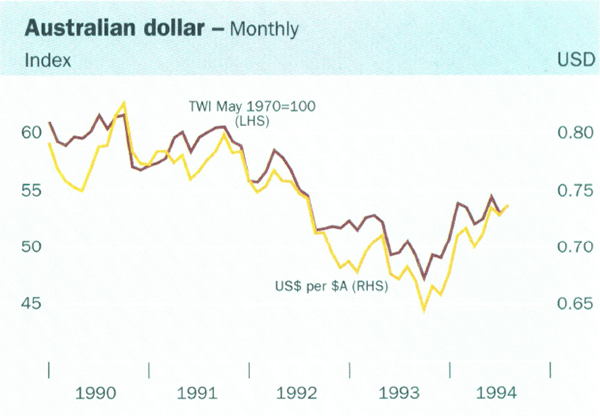
This levelling-out reflected the net effect of several factors, including higher commodity prices, turbulence in the bond market, narrowing short-term interest differentials relative to the United States, and the weakness of the US dollar. The latter fell substantially against both the yen (to a new low of under 97 yen) and the German mark, as concerns about the US trade imbalance with Japan intensified, and brighter prospects for the German and Japanese economies emerged. Reflecting the strong gains made between October and January, over the year to July 1994 the Australian dollar appreciated by 9 per cent in trade-weighted terms (to about 54) and by 10 per cent against the US dollar (to US74 cents). It remains, however, significantly below the TWI average of 57 applicable to the period since the mid 1980s (after it had depreciated by 35 per cent).
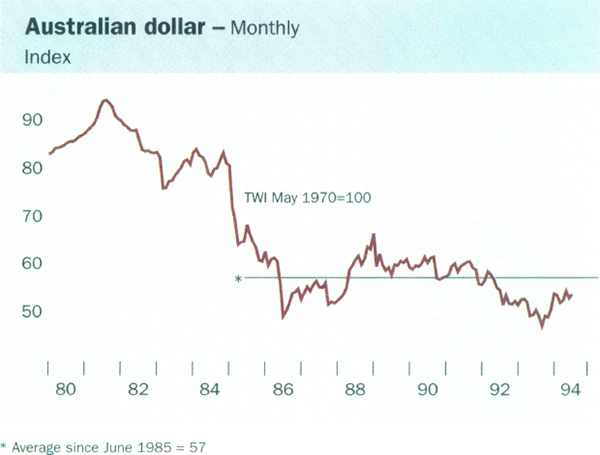
Bond yields continued to trend down in the major countries during the second half of 1993. In Australia this trend continued into January, notwithstanding the better prospects for economic growth and the fact that yields on US bonds had been rising since October. Continuing good news about inflation in Australia appears to have been a factor in this, along with the ongoing momentum of the long bull run in bonds, which was continuing even though the economic cycle was starting to turn. Bond yields in other countries in similar stages of the cycle – Canada, New Zealand and the United Kingdom – behaved in a similar way.
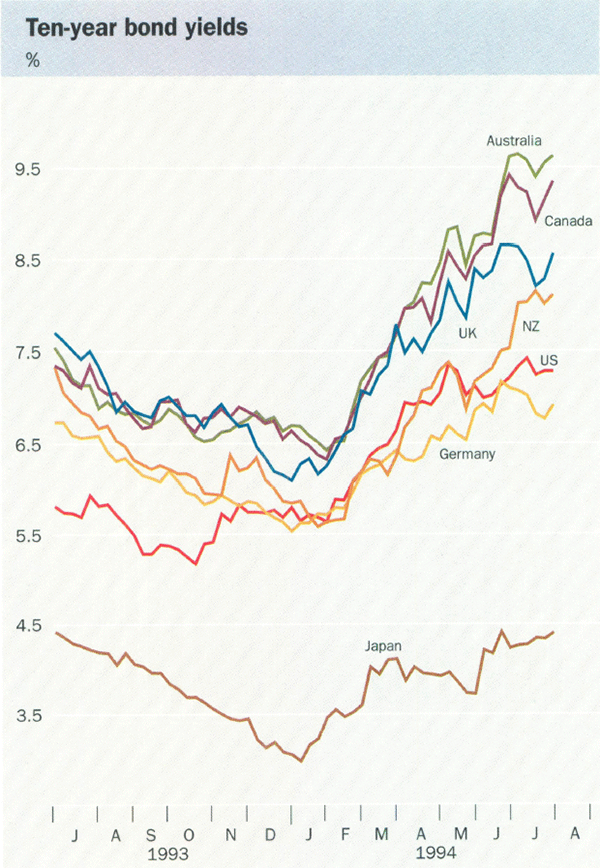
In retrospect, it is likely that bond yields “overshot” in a downward direction in 1993, thereby contributing to the sharpness of the turnaround which followed the tightening of monetary policy by the Fed in early February. That tightening, which saw cash rates in the United States raised by 0.25 per cent to 3.25 per cent, was followed by tightenings of similar magnitude in March and April. These also resulted in sharp rises in bond yields in the United States and other countries. In May, when the United States tightened again but by 0.5 per cent, this had a calming effect on markets in that country.
The global linkages of bond markets ensured that rising bond yields in the United States would flow quickly around the world. Initially, the countries most affected were other English-speaking countries where economic recovery was relatively well advanced. There was, however, also an immediate, though less pronounced, flow-on to most European countries and to Japan, even though those countries were further behind in the cycle. This changed as signs of recovery started to emerge in Germany and, less clearly, Japan, imparting more momentum to the rise in bond yields in those markets. These linkages, incidentally, mean that in the short term (and pending the establishment of convincing long-term track records) developments in the dominant US bond market will continue to exert some sway over markets in most other countries, including Australia.
In Australia bond yields rose from 6.4 per cent in late January, their lowest level for 20 years, to briefly touch 10 per cent in late June. By early August they had declined to under 9½ per cent. Initially, the rise in Australian yields broadly matched that in US yields, but subsequently became rather larger, suggesting that country-specific, as well as global, factors were at work.
The global movement to higher yields can be tied largely to the prospects for stronger world growth. Markets tended to equate prospective stronger growth with increased inflationary pressures, partly because the US economy was already operating at close to full capacity, and partly because commodity prices were on the rise. Markets also feared that the expected recovery in world growth would lead to capital shortages as private demands for funds picked up while government demands to finance large budget deficits remained very high.
Seen in these terms, a better outlook for world growth could be expected to be associated with some rise in interest rates, particularly given the relatively low starting levels. Yet the improvement in economic prospects was not so dramatic that it could explain the extent of the rise in bond yields which occurred. Inflation seemed well contained, while most forecasts for industrial countries showed little or no increase in inflation over the next couple of years. And commodity prices, while tending to rise, were not doing so at a pace that threatened major blow-outs in consumer prices.
|
Country |
Rise in long bond yield from 3 February to end July |
Level of bond yields at end July |
|---|---|---|
| United States | 1.3 | 7.1 |
| Canada | 2.7 | 9.2 |
| Australia | 3.1 | 9.5 |
| New Zealand | 2.5 | 8.1 |
| Japan | 0.9 | 4.4 |
| Germany | 1.1 | 6.8 |
| France | 1.4 | 7.2 |
| United Kingdom | 2.1 | 8.5 |
| Italy | 2.1 | 9.7 |
| Austria | 1.0 | 7.0 |
| Belgium | 1.5 | 8.0 |
| Denmark | 1.9 | 8.0 |
| Finland | 3.7 | 10.0 |
| Netherlands | 1.2 | 6.9 |
| Norway | 2.4 | 7.8 |
| Spain | 2.5 | 10.3 |
| Sweden | 4.0 | 10.9 |
| Switzerland | 1.0 | 5.1 |
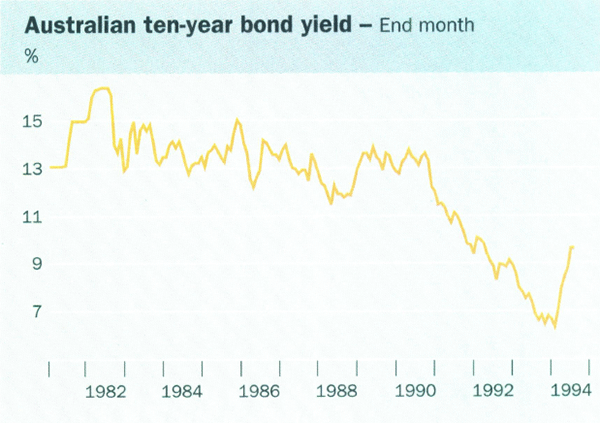
Part of the explanation of the global rise in bond yields appears to have as much to do with psychology as with economics. The first tightening by the Fed in early February became the occasion for a major reassessment of prospects for bond yields after a long period of falling yields. Market participants appear to have been surprised by the suddenness and size of the turnaround. This generated uncertainty and encouraged caution, and resulted in investors pulling back further from long-term investments. The situation was exacerbated by the degree of leverage employed by some hedge funds and other investors in funding their positions.
Besides the hedge funds, the activities of traditional funds managers also appear to have been important. The growth of these funds with their professional managers has added to market volatility, given that this group undertakes frequent marking to market of portfolios, and actively adjusts portfolios. The result can be abrupt movements in asset prices in response to uncertainty and changes in sentiment.
The larger rises in Australian bond yields point to the operation of some local factors. One general observation that stands out is that bond yields rose more in countries with track records of relatively high inflation, even if their recent experience has been good: the older the stains the harder they seem to be to wash out. This appears to have been the experience not only of Australia, but also of Sweden, Finland, Spain and, to a lesser extent, Canada. The fact that Australia was growing faster than almost all other industrial countries, and seemingly set for a further stimulus from higher commodity prices, tended to reinforce doubts in the market-place about the authorities' ability to manage this situation, and keep inflation under control. These doubts rested partly on recollections of what had occurred in similar circumstances in the past, and partly on comparisons with other countries which already had begun to tighten their monetary policies, such as the United States, Canada and New Zealand. While the Bank had acknowledged over a considerable period that policy would need to be tightened as the recovery took hold, it did not share the markets' judgment about the outlook for inflation in Australia, or about the urgency of policy action.
Share prices, which had risen during the period of falling bond yields, fell sharply in most countries from early February 1994 when rising bond yields reduced share valuations, notwithstanding the continuing good outlook for company profits. The main exception to this pattern was Japan, where share prices fell in the first half of the year and rose in the second half as signs that the economy was through the worst began to emerge. Share markets in all developed countries showed net rises over 1993/94, although those in the United States, Japan and the United Kingdom were modest (about 5 per cent). Notwithstanding the sharp rise in bond yields, Australia recorded one of the largest increases in share prices among the developed countries, showing a net rise of 11 per cent over the year to end July. Share markets in the smaller Asian economies performed much better, with large inflows of foreign funds adding to volatility but contributing to net increases over the year of the order of 20 to 30 per cent.
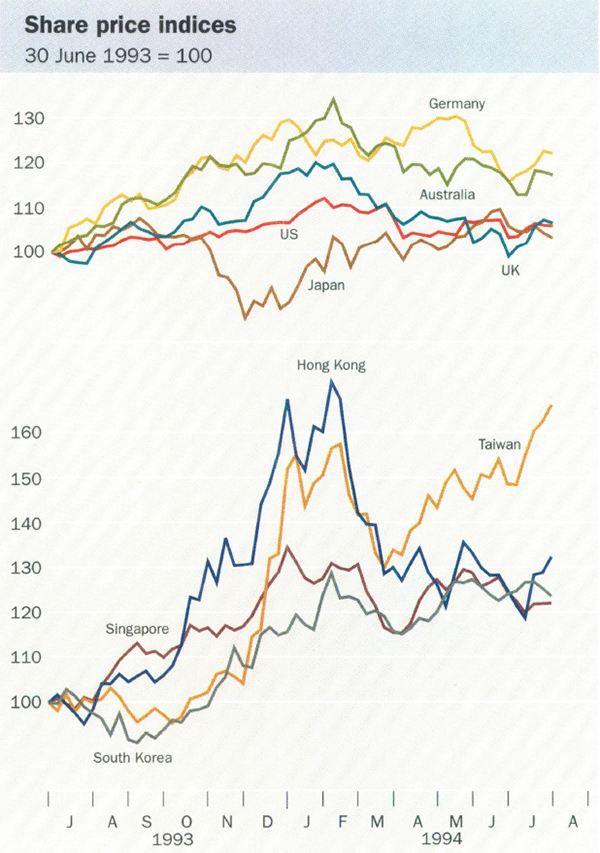
Short-term security yields, which largely reflect market expectations of future cash rates, were fairly steady through the first half of 1993/94, although they rose temporarily in September 1993 when the markets priced in the possibility of a tightening in policy to support the falling exchange rate. As the Australian economy gathered momentum and the prospect of some tightening came closer, short-term yields rose, with yields on 90-day and 180-day securities in June reaching 5.8 per cent and 6.3 per cent, respectively. Yields retreated a little in July but remained well above the cash rate at 5.4 per cent (90 days) and 6.0 per cent (180 days).
The Bank's Market Operations
The Bank's foreign exchange operations were much reduced in 1993/94, with net sales of foreign exchange to the market of $A1.8 billion, compared with $10.4 billion in 1992/93 and $4.4 billion in 1991/92. Almost all of the intervention in the past year occurred in the September quarter when the Bank judged the fall in the exchange rate to have been overdone and was concerned that further falls could have threatened inflation objectives. The Bank preferred intervention in the market to more direct action through increases in interest rates because of the adverse consequences of higher interest rates on an economy still in the early stage of recovery. Apart from one other occasion in November, when the exchange rate fell sharply in thin market conditions, the Bank did not intervene in 1993/94.
The Bank's operations in domestic markets in the past two years are summarised in the following table.
| 1992/93 | 1993/94 | ||
|---|---|---|---|
| Treasury notes | – purchases | 6.6 | 7.3 |
| – sales | 1.1 | 4.6 | |
| Repurchase | – purchases | 71.6 | 80.9 |
| agreements | – sales | 70.3 | 82.9 |
| Bonds | – purchases | 2.7 | 1.0 |
| – sales | 0.2 | 1.8 |
The bulk of the Bank's transactions are for liquidity and monetary management purposes, and are undertaken in Treasury notes and repurchase agreements (against Treasury notes and bonds). The Bank is in the money market as a buyer or seller on most days and its transactions in these instruments are typically of less than 30 days to maturity. The purpose of the transactions is to reposition cash from day to day and week to week so as to stabilise liquidity conditions in the money market at around the Bank's desired cash rate.
Transactions in the Commonwealth Government bond market are considerably smaller. As the table shows, total turnover last year was similar to that in 1992/93, although in that year transactions were skewed more towards purchases. Sales during the past year were concentrated in the first half of the year when the Bank took advantage of strong market conditions to reduce somewhat its holdings of long bonds, replacing these with shorter-term assets, such as Treasury notes. As yields rose in the second half of the year, the Bank added to its holdings, judging that the higher yields then on offer would prove attractive in the longer term.
The Bank currently holds $10 billion, or about one-third of its total assets, in Commonwealth Government bonds and it tends to be a net buyer of Commonwealth Government bonds over time as its balance sheet grows. The Bank's broader responsibilities mean that its involvement in this market is dictated by considerations other than seeking to maximise short-term gains. The main considerations are:
- to manage the composition of the Bank's portfolio between Commonwealth Government bonds and foreign currency assets (which are held mainly in the form of bonds issued by foreign governments). In most cases, these transactions arise as a consequence of intervention in the foreign exchange market (since intervention involves a switch between domestic and foreign assets);
- to contribute to the smooth and efficient operation of the market by, for example, switching stocks with other market participants to provide stocks temporarily in short supply (the Bank always subscribes to new issues of bonds so that it has stock to make available if temporary market shortages occur); and
- to change the average duration of its bond holdings. In the normal course, the aim is to maintain a fairly neutral average duration – that is, one that is broadly in line with the average duration of the bonds on issue – but on occasions the Bank may choose to adjust the duration of its portfolio to reflect changes in market conditions. In doing so, it is of course mindful of the large size of its holdings and the need for any shifts in its portfolio to be gradual and to be undertaken only in circumstances when they do not disrupt the market (or might even help to calm markets during times of stress, as with its purchases over recent months).